- Home
- INTERMEDIATE ALGEBRA
- Course Syllabus for Algebra I
- Mid-Plains Community College
- FRACTION OF A WHOLE NUMBER
- Systems of Linear Equations
- MATH FIELD DAY
- Course Outline for Finite Mathematics
- Calculus
- Algebra Final Examination
- Math 310 Exam #2
- Review of Trigonometric Functions
- Math 118 Practice test
- Precalculus Review
- Section 12
- Literal Equations
- Calculus Term Definitions
- Math 327A Exercise 2
- Public Key Algorithms II
- Maximizing Triangle Area
- Precalculus I Review for Midterm
- REVIEW OF A FIRST COURSE IN LINEAR ALGEBRA
- Math 6310 Homework 5
- Some Proofs of the Existence of Irrational Numbers
- ALGEBRAIC PROPERTIES OF MATRIX OPERATIONS
- Math 142 - Chapter 2 Lecture Notes
- Math 112 syllabus
- Math 371 Problem Set
- Complex Numbers,Complex Functions and Contour Integrals
- APPLICATIONS OF LINEAR EQUATIONS
- Week 4 Math
- Fractions
- Investigating Liner Equations Using Graphing Calculator
- MATH 23 FINAL EXAM REVIEW
- Algebra 1
- PYTHAGOREAN THEOREM AND DISTANCE FORMULA
- Georgia Performance Standards Framework for Mathematics - Grade 6
- Intermediate Algebra
- Introduction to Fractions
- FACTORINGS OF QUADRATIC FUNCTIONS
- Elementary Algebra Syllabus
- Description of Mathematics
- Integration Review Solutions
- College Algebra - Applications
- A Tip Sheet on GREATEST COMMON FACTOR
- Syllabus for Elementary Algebra
- College Algebra II and Analytic Geometry
- Functions
- BASIC MATHEMATICS
- Quadratic Equations
- Language Arts, Math, Science, Social Studies, Char
- Fractions and Decimals
- ON SOLUTIONS OF LINEAR EQUATIONS
- Math 35 Practice Final
- Solving Equations
- Introduction to Symbolic Computation
- Course Syllabus for Math 935
- Fractions
- Fabulous Fractions
- Archimedean Property and Distribution of Q in R
- Algebra for Calculus
- Math112 Practice Test #2
- College Algebra and Trigonometry
- ALGEBRA 1A TASKS
- Description of Mathematics
- Simplifying Expressions
- Imaginary and Complex Numbers
- Building and Teaching a Math Enhancement
- Math Problems
- Algebra of Matrices Systems of Linear Equations
- Survey of Algebra
- Approximation of irrational numbers
- More about Quadratic Functions
- Long Division
- Algebraic Properties of Matrix Operation
- MATH 101 Intermediate Algebra
- Rational Number Project
- Departmental Syllabus for Finite Mathematics
- WRITTEN HOMEWORK ASSIGNMENT
- Description of Mathematics
- Rationalize Denominators
- Math Proficiency Placement Exam
- linear Equations
- Description of Mathematics & Statistics
- Systems of Linear Equations
- Algebraic Thinking
- Study Sheets - Decimals
- An Overview of Babylonian Mathematics
- Mathematics 115 - College Algebra
- Complex Numbers,Complex Functions and Contour Integrals
- Growing Circles
- Algebra II Course Curriculum
- The Natural Logarithmic Function: Integration
- Rational Expressions
- QUANTITATIVE METHODS
- Basic Facts about Rational Funct
- Statistics
- MAT 1033 FINAL WORKSHOP REVIEW
- Measurements Significant figures
- Pre-Calculus 1
- Compositions and Inverses of Functions
Math 118 Practice test
1. Give an example of an irrational number________, a rational number _______, and integer_____, a natural number.
2. True or false: .121212… is a rational number.
3. True or false: Every real number is rational.
4. True or false: Every integer is rational.
Use the distributive property to multiply, then collect like terms:

7.  is an example of
the ______________ law of multiplication.
is an example of
the ______________ law of multiplication.
8.  is an example of the
______________ law.
is an example of the
______________ law.
9.  is an example of
the ____________ law of multiplication.
is an example of
the ____________ law of multiplication.
Evaluate:
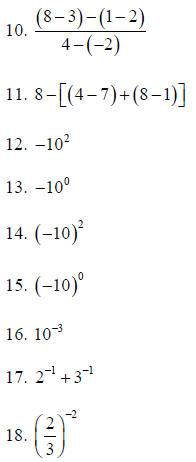
Rewrite using positive exponents only:
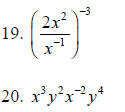
Write in scientific notation:
21. 0.000000014
22. 520,000,000,000
Write in decimal notation:

Solve for x:

29. Evaluate the expression
 for
for 
30. Evaluate the expression
 for
for 
Solve the inequality. Write your answer as a set, in interval notation, and graph the solution.
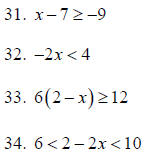
Math 118 Practice Test 2
Solve for x:

3. A vertical line has slope _______ and a horizontal line has slope ________.
4. The equation of the x-axis is __________ and the equation of the y-axis is _____.
5. The equation for a vertical line through (2,3) is _______ and the equation for the horizontal line through (2,3) is ___________.
6. A line perpendicular to a line with slope 2 has slope _____, and a line perpendicular to a line with slope 2/3 has slope __________
7. The equation for the line with slope –3 and y-intercept 6 is ________
8. Find the equation for the line with slope 1/2 through the point (-5,4)
9. Find the equation for the line through the points (-1,3) and (3,1).
10. Find the equation for the line through the point (2,5)
perpendicular to the line 
11. Determine whether the ordered pairs
 represents a function. (Answer: yes, because
no first number is repeated.)
represents a function. (Answer: yes, because
no first number is repeated.)
12. What is the domain of the function above?
13. What is the range of the function above?
14. If the function above is called f, what is
 ?
?
15. Every line determines a function except a ________ line.
16. Let  with domain
[-3,7]. What is the range of this function?
with domain
[-3,7]. What is the range of this function?
17. For the function above, what is
 ? (Partial answer:
? (Partial answer:
 doesn’t exist because –4 is not in the
domain of f.
doesn’t exist because –4 is not in the
domain of f.
18. The picture represents a function because it passes the ________ test.
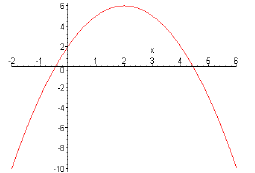
19. If the picture represents the function f, then the domain of f is ______ and the range of f is _____.
20. For the picture above,
21. Give an example of a polynomial of degree 3 with leading coefficient 4 and constant –5
22. For the polynomial  the degree is ____, the leading coefficient is _____ and the constant is ______.
the degree is ____, the leading coefficient is _____ and the constant is ______.
23. If you add a polynomial of degree 4 to a polynomial of degree 3 the degree of the sum will have degree _____
24. If you multiply a polynomial of degree 4 to a polynomial of degree 3 the degree of the product will be ____.
25. Add 
26. Subtract: 
27. Multiply: 
28. Multiply: 
29. Multiply: 
30. Divide: 
31. Factor out the greatest common factor:
32. Factor by grouping: 
Math 118 Practice Test 3:
1. For the polynomial  the degree is ______, the leading coefficient is _______, and the constant is
__________.
the degree is ______, the leading coefficient is _______, and the constant is
__________.
2. Give an example of a polynomial of degree 2 with leading coefficient –1 and constant 7
3. Rewrite the polynomial
 in standard form.
in standard form.
4. For the polynomial in number 3, the degree is _______, the leading coefficient is _______ and the constant is ______.
5. Add: 
6. Subtract: 
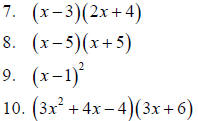
11. Divide: 
12. Factor: 
13. Factor the perfect square:

14. Factor the difference of two squares:

15. Factor the difference of two cubes:

16. Factor the sum of two cubes:

17. Graph  by using the
following steps:
by using the
following steps:
18. 
19. Does the parabola open up or down? _______
20. How can you easily tell? Because _______
21. The vertex is ( ___, ___)
22. The y-intercept, i.e. the point where the graph crosses the y-axis is ( ___, ___)
23. The x-intercepts, i.e. the points where the graph
crosses the x-axis are ( ___, ___)
and ( ___, ___)
24. Plot the points above, and graph the parabola.
25. If the vertex of a parabola is lies above the x-axis and the parabola opens downward, how many x-intercepts will it have? ________
26. Evaluate the numbers:

27. Write in simplest radical form:


28. Solve for x:



